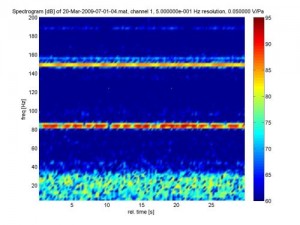
In this spectrogram the signals at 85Hz and 150Hz are most prominent. These signals can be heard as a hum. The hum also depends on the distance from the source that emits a signal and the level of the transmitted signal. How the hum is heard and experienced is very personal.
As of 21 June 2010, the National Aerospace Laboratory (NLR) will conduct research on behalf of the Dutch Ministry of Housing, Spatial Planning and the Environment’s Inspectorate (VI) and the State Supervision of Mines (SodM), following complaints from residents of Zuidhorn municipality.
For a number of years, some Zuidhorn residents have complained of hearing low, humming sounds in their surroundings and have also been bothered by vibrations. There are various potential sources for this noise. To find the source, VI and SodM have asked NLR to conduct comprehensive research. Special , designed by NLR , measuring equipment will be used during the course of the investigation. In order to record the low-frequency tones, NLR will place highly sensitive microphones in the gardens and homes of the affected residents, and also at the possible sources. These low-frequency noises will then be measured for two weeks, and meanwhile, during this period, the residents will also keep logbooks.
The noises recorded in the residents’ homes will be compared to the noises recorded at the possible sources. In addition, a vibration sensor will be placed in a home to record the vibrations that occur there.
NLR expects to have completed the analysis of its measurements in October 2010. Based on these findings, VI and SodM, in consultation with other relevant parties, will then determine what, if any, additional steps should be taken.
For more information about this research of low-frequency noise, please contact Mr. Van Dalen, of SodM, at: +31 (0)70 -3798452


